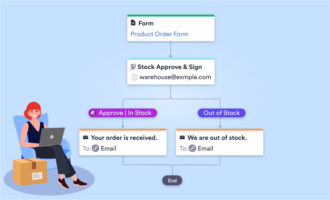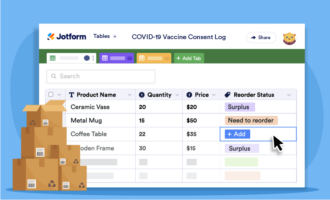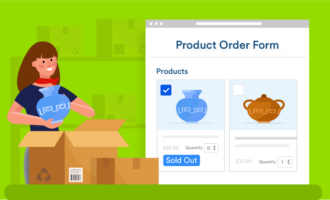Tips to avoid stockouts
- Set a standard level of stock
- Maintain safety stock
- Monitor supplier lead times
- Forecast demand cycles
- Pay attention to consumer trends
- Use inventory management tools
Nobody wants to see the words “out of stock” when they’ve found the perfect item online. It’s disappointing for customers — and it’s nightmarish for businesses, because stockouts are a surefire way to lose out on revenue. Whatever you sell, you should know why stockouts happen and learn several strategies for avoiding them.
What is a stockout?
A stockout is when a business can’t fulfill a product order because inventory is unavailable. This is also called an out-of-stock event. Stockouts can be particularly challenging for e-commerce businesses. If a customer sees an item is out of stock and has no way to ask someone when it will be available again (like they could in a brick-and-mortar business), they’ll quickly look for the product elsewhere.
What causes stockouts?
Stockouts can happen for a variety of reasons. Sometimes those reasons may be out of your control — like production and delivery delays. Here’s a list of common stockout causes:
- Flawed inventory management
- Incorrect inventory count
- Ineffective forecasting processes
- Underestimated demand
- Low or non-existent safety stock
- Failure to reorder in a timely manner
How to avoid stockouts for your e-commerce business
When you operate an online store, stockouts can do serious damage to your business. Customers are likely to become frustrated or disappointed and may view your store as disorganized or mismanaged. You may miss out on potential sales and opportunities to convert prospective buyers into loyal, returning customers.
To avoid stockouts in your e-commerce business, try these strategies.
Set a standard level of stock
For each product in your store, you should set a minimum quantity you aim to keep in stock at all times. To calculate this number, take into account shopping trends and behaviors, forecasted demand, and shipping lead times.
For example, if a product is in high demand and takes three months to ship from your supplier, you should have more of it in stock than a product with low demand and a one-week lead time for shipping. If you use an inventory management system, create automated restock alerts accordingly.
Maintain safety stock
If a product is performing well or is likely to sell out fast, keeping safety stock on hand is a good idea. A safety stock acts as a safety net in emergencies.
If one of your products experiences a huge surge in demand and sells out, maintaining a safety stock can help you avoid a stockout until you can replenish the supply. The key here is that you shouldn’t count your safety stock toward your storefront’s available stock.
Since this method doesn’t work well for perishable items with a short shelf life and requires you to use extra storage space, you can only use it for select items.
Monitor supplier lead times
Lead time is the amount of time from when you order a shipment from your supplier to when you receive it. Keep track of lead times so you can calculate your suppliers’ average and maximum lead times. These numbers are critical when you calculate reorder points.
If the lead time you use to calculate reorder points is shorter than your suppliers’ actual average, you risk the chance of running out of stock before you receive your new shipment.
Forecast demand cycles
Accurately predicting product demand is huge for e-commerce businesses. Forecasting demand isn’t an easy task, but the effort is well worth it.
Two major areas to consider when forecasting demand cycles are your store’s sales history and current economic conditions. Look at this data through local, regional, national, and global lenses.
Also consider seasonality when analyzing historical inventory data. All this information can help you prepare for upticks in product demand.
Pay attention to consumer trends
Historical inventory data can help you forecast product demand — but what if you don’t have a lot of historical data to work from or you want to expand your inventory?
Paying attention to consumer trends in your market is critical. You may find that there are new products your target customers are buying or that certain styles are making a comeback. Consider these and factors when ordering new products and replenishing inventory.
Use inventory management tools
Manually inputting data into an Excel spreadsheet might suffice for small businesses just starting out, but manually tracking inventory can quickly become a nuisance as your online business grows. It’s a time-consuming task, and it increases the chances that little things will slip through the cracks. That’s why implementing inventory management tools with features like restock alerts is a best practice, even when you’re just starting out.
How to avoid stockouts with Jotform
The right inventory management tools don’t have to be complex or expensive. Avoiding stockouts is already challenging enough — so the tools you use should make your life simpler. Jotform is easy to use and allows businesses to sell products, collect payments, and receive automatic notifications when stock levels are low.
Jotform’s Form Builder offers a stock control feature for order forms, allowing you to set the available quantity of a particular product so it automatically updates as customers purchase your products. If you have a product with multiple size or style options, you can also set unique quantities for each product variant.
The stock control feature also allows you to set up automated low-stock alerts, notifying you via email when stock levels reach a certain point. You can also use this feature to display a note to customers on your storefront that a product is low in stock.
Keeping track of your business’s inventory is no easy feat, but by taking a few precautions and using the resources at your disposal, you won’t have to worry about how to avoid stockouts.




















Send Comment: